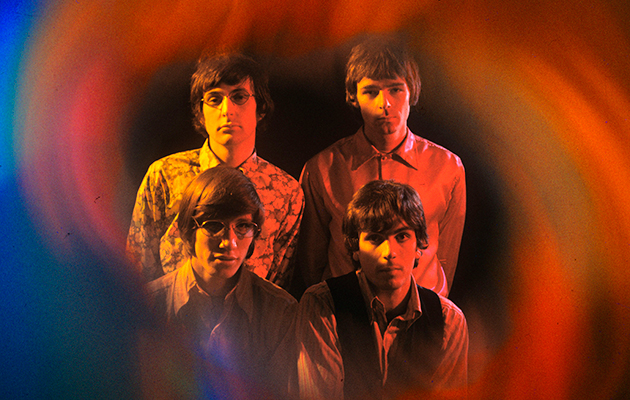With the release on March 24 of Pink Floyd The Early Years, 1965 – 1972: The Individual Volumes and the opening of the The Pink Floyd Exhibition: Their Mortal Remains exhibition at the V&A on May 13, we dig deep into the group’s archives, as band members, collaborators and associates lead us fr...
In a last desperate attempt to record a hit before beginning their American tour, Pink Floyd headed into Abbey Road on October 26, with Norman Smith and Ken Scott, to cut “Apples And Oranges”: Jenner today describes the song as “very bland”, while King instead praises the lyric and its “amazing symbolist poetry-cum-vernacular chatting”. Barrett’s mental deterioration was becoming more obvious, yet Ken Scott managed to get through the epic session without sensing a problem.
“I can’t say that I noticed it,” he says. “It wasn’t until a bit later that I started to realise that Syd wasn’t necessarily all there. It was my first 24-hour session, and I have a very strong recollection of using NoDoz and really suffering for the next couple of days because I’d never used anything like that before.”
For those closer to the group, Barrett’s problems were becoming painfully apparent, but still the American tour went ahead. “We didn’t recognise what was going on,” says Mason, “I think because we were all so focused on wanting the band to be a success. He really should have retired three, four or six months earlier. He became really quite psychotic – you know, attacking girlfriends. We should have recognised what was happening and gone our separate ways, but we didn’t, because we thought we needed him, and we didn’t know enough about what was going on.
“I don’t think Syd lost interest in writing songs; he lost interest in the machinery of doing Fab 208 photoshoots, all that sort of stuff. Later on, the playing went to pot, but I think it was the whole thing of being in a pop music industry, when he thought he wanted to be an artist.”
“I think he was confused by how cosmically significant everything [in the industry] was,” suggests Peter Jenner. “Because it wasn’t cosmically significant to him, I suspect; that’s what he did and that’s who he was. [But] there was pressure on him from the people around him, from the band, from us, from life.”
“He had a different orientation,” suggests Joe Boyd. “The rest of the group had now had two hit singles and they were on their way, as far as they were concerned. They’d dropped out of architecture school, very hesitantly, whereas Syd was just out; he had never had any doubt, he wasn’t ambitious in any normal sense. So the rest of the band had an agenda which was, ‘OK, we’ve got a record coming out next month, we’ve got a tour planned, we’ve got dates booked, we have a shot at the gold ring here, let’s not fuck it up…’ I’m not suggesting for a minute that those guys were trying to compromise the musical vision that they shared with Syd, though. He was definitely on the cutting edge of certain things, but he was also quite retrograde in many ways, such as his love of Englishness and the countryside. He wasn’t the groover who was gonna be down the King’s Road. It was more that he was an outsider, he was separate from all those things.”
The American tour went as disastrously as could have been expected, in hindsight, with Barrett dead-eyed and often refusing to mime on whatever TV show he was coerced to appear on; Waters had to mouth along to “See Emily Play” on one occasion. On November 4, Barrett and Pink Floyd headed to San Francisco to play the city’s Winterland Auditorium, and the heads and hippies of the city, no strangers to LSD, could tell something was up with Barrett. “The kids in San Francisco were very nice, very kind and helpful,” recalls Andrew King. “They could see what was going on, and lots of them were very supportive. But those television shows…”
When the group returned to the UK in mid-November, Barrett suggested a revamped lineup featuring trumpets, saxophones and backing singers. “In a free jazz sort of a way,” recalls Andrew King. “Syd just wanted to change everything, but I think most of the band were probably more conservative.”
“Roger definitely fancied success,” says Peter Jenner, “and I guess the others did, because they were getting paid and it was better than going to college. But the band were really struggling to play gigs – if Syd did keep to the setlist, he wouldn’t play the arrangement they had rehearsed. It was very hard to see how they coped with it, and the answer was that, in the end, they didn’t.”
Just how addled by LSD and psychological problems Barrett was is difficult to confirm, though – perhaps he, an eternal outsider, had simply had enough of being a pop star, churning out hits and playing gigs to unappreciative crowds. The Floyd’s December 20 session for the BBC’s Top Gear (included on The Early Years) finds Barrett on form, with the band strangely performing the ‘rejected’ tracks, “Vegetable Man”, “Scream Thy Last Scream” and “Jugband Blues”. The latter appeared as the final track of A Saucerful Of Secrets, while the other two passed into myth. “Apples And Oranges”, meanwhile, that longed-for hit, failed to chart on release in November; the band wouldn’t reach the singles charts for another 12 years.
“Those [other] songs were suppressed. That was what was weird,” says Jenner. “But I felt that it was all art and that it should all be heard, so stuff did leak out. I was not un-responsible for some of the leakage. I did think they were important, because if you wanted to know about Syd Barrett, you’d better listen to those tracks.”



